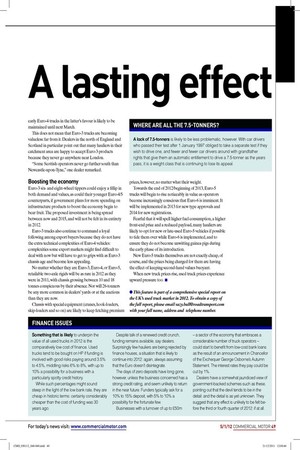A lasting effect
Page 41

If you've noticed an error in this article please click here to report it so we can fix it.
early Euro-4 trucks in the latter’s favour is likely to be maintained until next March.
This does not mean that Euro-3 trucks are becoming valueless: far from it. Dealers in the north of England and Scotland in particular point out that many hauliers in their catchment area are happy to accept Euro-3 products because they never go anywhere near London.
“Some Scottish operators never go further south than Newcastle-upon-Tyne,” one dealer remarked.
Boosting the economy
Euro-3 sixand eight-wheel tippers could enjoy a illip in both demand and values, as could their younger Euro-4/5 counterparts, if government plans for more spending on infrastructure products to boost the economy begin to bear fruit. The proposed investment is being spread between now and 2015, and will not be felt in its entirety in 2012.
Euro-3 trucks also continue to command a loyal following among export buyers because they do not have the extra technical complexities of Euro-4 vehicles: complexities some export markets might ind dificult to deal with now but will have to get to grips with as Euro-3 chassis age and become less appealing.
No matter whether they are Euro-3, Euro-4, or Euro-5, retailable two-axle rigids will be as rare in 2012 as they were in 2011, with chassis grossing between 10 and 18 tonnes conspicuous by their absence. Nor will 26-tonners be any more common in dealers’ yards or at the auctions than they are now.
Chassis with special equipment (cranes, hook-loaders, skip-loaders and so on) are likely to keep fetching premium prices, however, no matter what their weight.
Towards the end of 2012/beginning of 2013, Euro-5 trucks will begin to rise noticeably in value as operators become increasingly conscious that Euro-6 is imminent. It will be implemented in 2013 for new type approvals and 2014 for new registrations.
Fearful that it will spell higher fuel consumption, a higher front-end price and a reduced payload, many hauliers are likely to opt for new or late-used Euro-5 vehicles if possible to tide them over while Euro-6 is implemented, and to ensure they do not become unwitting guinea pigs during the early phase of its introduction.
New Euro-5 trucks themselves are not exactly cheap, of course, and the prices being charged for them are having the effect of keeping second-hand values buoyant.
When new truck prices rise, used truck prices experience upward pressure too. ■ ● This feature is part of a comprehensive special report on the UK’s used truck market in 2012. To obtain a copy of the full report, please email suzy.bull@roadtransport.com with your full name, address and telephone number.
WHERE ARE ALL THE 7.5-TONNERS?
A lack of 7.5-Conners is likely to be less problematic, however. With car drivers who passed their test after 1 January 1997 obliged to take a separate test if they wish to drive one, and fewer and fewer car drivers around with grandfather rights that give them an automatic entitlement to drive a 7.5-tonner as the years pass, it is a weight class that is continuing to lose its appeal.
FINANCE ISSUES
Something that is likely to underpin the value of all used trucks in 2012 is the comparatively low cost of finance. Used trucks tend to be bought on HP if funding is involved with good risks paying around 3.5% to 4.5%, middling risks 6% to 8%, with up to 10% a possibility for a business with a particularly spotty credit history.
While such percentages might sound steep in the light of the low bank rate, they are cheap in historic terms: certainly considerably cheaper than the cost of funding was 30 years ago. Despite talk of a renewed credit crunch, funding remains available, say dealers. Surprisingly few hauliers are being rejected by finance houses, a situation that is likely to continue into 2012: again, always assuming that the Euro doesn’t disintegrate.
The days of zero deposits have long gone, however, unless the business concerned has a strong credit rating, and seem unlikely to return in the near future. Funders typically ask for a 10% to 15% deposit, with 5% to 10% a possibility for the fortunate few.
Businesses with a turnover of up to £50m – a sector of the economy that embraces a considerable number of truck operators – could start to benefit from low-cost bank loans as the result of an announcement in Chancellor of the Exchequer George Osborne’s Autumn Statement. The interest rates they pay could be cut by 1%.
Dealers have a somewhat jaundiced view of government-backed schemes such as these, pointing out that the devil tends to be in the detail: and the detail is as yet unknown. They suggest that any effect is unlikely to be felt before the third or fourth quarter of 2012: if at all.













































